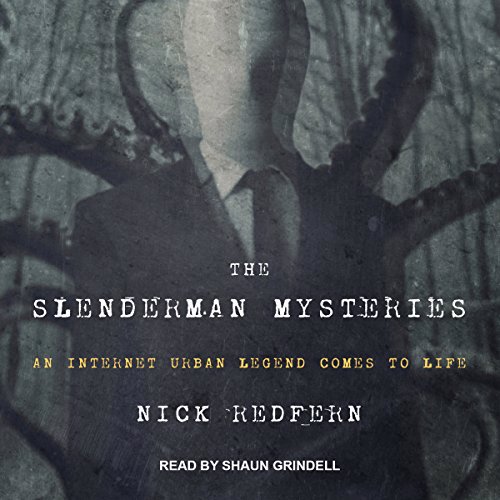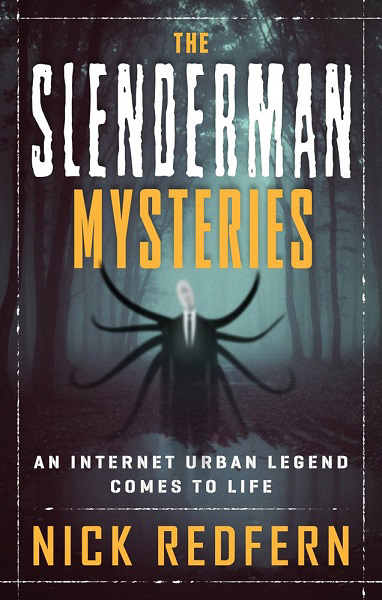More on the Matter of the Most Dangerous Creature of the Mind: The Slenderman

You may have read the article I wrote a few days ago about Jack the Ripper possibly having been a thought-form/Tulpa. With that said, I thought I would push things a bit further. There’s absolutely no doubt at all that we would not have a Slenderman phenomenon had it not been for Eric Knudsen. In a strange fashion, he fathered the creature; though that was surely not his intent when he lit the flame. When, on June 10, 2009, he created the Slenderman, Knudsen probably had no idea as to where things were destined to go. Who could have foreseen what was to come? Probably no-one. With hindsight, though, we should not be overly surprised that the posting to Something Awful of a pair of doctored photographs should have provoked such widespread interest, obsession and even, eventually, disturbing mania. After all, Knudsen’s creation was an ingenious and eerie patchwork collection of the “best” parts of some of the most menacing figures that dwell in the domain of the supernatural: Mothman, the Men in Black, the Shadow People, and the Mad Gasser of Mattoon, were just a few of them. Taking inspiration from the writings of Stephen King and H.P. Lovecraft only added to the freaky flavor. Indeed, combining the MIB and tentacle-waving Cthulhu is all but guaranteed to catch peoples’ attention. And, as history has shown, it did exactly that. Big time.
But, what really stood out was the incredible speed with which the phenomenon of the Slenderman grew. Recall what Ian “Cat” Vincent had to say on this very issue: “The thing that really specifically grabbed me and made the story interesting enough for me to write articles is the rapidity of it.” It was, as Vincent rightly noted, “the right monster at the right time and for the right audience.” Vincent is not wrong (Redfern-Vincent, interview, 2017). At specific times throughout history, certain things do just seem to gel: the rise of the “Beats” in the late-1940s, the birth of rock and roll, the punk-rock explosion of the 1970s, and, of course, the dawning of the Internet – the latter, without which, the Slenderman would surely never have come to life. Or, at least, his position in today’s culture would certainly be radically reduced and marginalized. So, the Slenderman came along at what turned out to be, for him, just about the most fortuitous time possible in the history of human civilization. Even before he became a supernatural entity that stepped out of the confines of the Net and into our world, the Slenderman was already influencing minds – and to the point where Eric Knudsen’s original posting was quickly added to, elaborated on, and then went on to spawn a wealth of Slenderman-themed blogs, websites, the Marble Hornets series, and even a Wikipedia page on ol’ Slim himself. None of this occurred in weeks or even months. It all happened within days.

The amazing speed with which an idea became an undeniable phenomenon almost certainly, although probably unwittingly, led to the creation of a second Slenderman. Eric Knudsen’s fictional freak had a rival of sorts. It’s a rival that, in many respects, is seen as far more significant and dangerous than the original version. I am, of course, referring to the thought-form / Tulpa version of the Slenderman – which may have been born out of Chaos Magic. If one was not enough to send chills through the minds and bodies of thousands, soon there were two of the damned things, as was made clear when, on November 6, 2009, George Noory – at Coast to Coast AM – opened up the airways to allow Slenderman witnesses to discuss their experiences with the made-up monster. Time and again, we have seen examples of how the human mind can – and under the right, particular circumstances – bring to life some form of entity that is purely a construct of the human mind. Yes, the likes of Alexandra David-Neel and Dion Fortune went out of their way to deliberately try and create Tulpas – and they succeeded. In doing so, though, they found to their costs that their mind-monsters were not their friends: they were hostile, mischievous, dangerous and malevolent things.
There is, however, a big difference between what was happening with Fortune and David-Neel nearly a century ago and what is happening now, in our society and culture of the early part of the 21st century. Both women consciously tried to create, and succeeded in creating, Tulpas. There is, however, very little evidence or testimony that suggests large-scale attempts have been made to create a real-world Slenderman. Instead, what we have today is a massive fascination for, and a belief in, the Slenderman. That collective fascination and belief, particularly in relation to its teenaged following, has led to the inadvertent creation of the Slenderman, rather than a deliberate creation. Of course, though, for the Slenderman that distinction is utterly irrelevant: he’s just pleased that he is here, regardless of how, exactly, he got here. And, now that he’s here, it’s pretty much a given that he has no intention of being deconstructed. That may not be the whole story of how the Slenderman has achieved a foothold in our world, though. If it’s true that we are all living in a real-life equivalent of the story that is played out in 1999’s The Matrix and its sequels, then just about all things conceivable are possible. In a Matrix-type world, whatever is uploaded and let loose can be said to be real. Why? Because reality isn’t all that it appears to be. Reality is whatever the creators want it to be. And that just might include the Slenderman. That’s not the end of things, though.
One of the most intriguing aspects of the entire Slenderman phenomenon is the undeniable fact that even though the creature was not on anyone’s radar until June 2009, there are some truly weird stories that push the barriers of belief in such things back centuries. The Pied-Piper of Hamelin is a perfect example. Native American legends talked of the Tall Man Spirit, which has now been upgraded to Walking Sam. Also centuries ago, Germany had the Bösermann, the Popelmann, the Busbeller, and Der Schwarzermann. They too are astonishingly Slenderman-like. All of these encounters and incidents have one thing in common, regardless of their geographical location: they all occurred long before Eric Knudsen created the Slenderman. Is there an explanation for all this? I refer you to the words of Robin Swope, with whom I concur when he says that Eric Knudsen unknowingly picked up something that already existed – a kind of ancient archetype.

Let’s all remember, too, that many of what we might call Knudsen’s “entities of inspiration” were not fictional creatures. Rather, they were established things in the world of the paranormal: Mothman, the MIB, and the Shadow People, to name just three. Even when Knudsen did take some degree of inspiration from the domain of literary fantasy, he chose none other than H.P. Lovecraft, among others. As we have seen, Lovecraft’s creations may not have been fantasy-based, after all: they just might have been real monsters and malignant things that invaded Lovecraft’s dreams, but which gave the impression that what was real was actually the product of a vivid and eccentric mind – when it was actually the other way around. John Keel, author of The Mothman Prophecies, warned time and time again about the dangers of thinking about, and pondering on, supernatural entities. And he offered those warnings for a very good reason: Keel, to his eternal cost, had done precisely that himself.
He thought about the things he really should not have been thinking about. And what happened? He had run-ins with the very things that were on his mind, that’s what. Eric Knudsen may have thought he created the Slenderman, but as the material above shows, we can make a good argument that the Slenderman is a very old entity; one which, in an almost primordial form, got its grips into Knudsen when he was seeking and reaching for the ultimate Internet monster. Knudsen was, then, far less a creator of a monster and far more a conduit for something that had remained dormant for a while, but which relished the opportunity to be resurrected on the world’s stage. All of which brings us to the most disturbing aspects of the Slenderman phenomenon: that which concerns the terrible and varied attacks and killings of 2014, many of which have Slenderman-themed aspects attached to them.
Up until the summer of 2014, the number of people who had an awareness of the Slenderman was pretty much dictated by those who had gravitated to the likes of Marble Hornets and Something Awful. That all changed following Anissa Weier’s and Morgan Geyser’s violent attack on Payton Leutner, at Waukesha, Wisconsin’s David’s Park on May 31, 2014. In no time at all, the Slenderman was big news. It was mainstream news, too: CNN, MSNBC, Fox News and many more major outlets covered the story. And, they continue to cover the story when there is something new to report on, which is frequently. After that, we had attacks on a parent in Hamilton County, Ohio; a house burned down in Pasco, Florida; and the deadly rampage of Jerad and Amanda Miller in Las Vegas, Nevada. All of these events had significant links to the growing Slenderman phenomenon, which brings us to what is undoubtedly the most controversial part of the entire Slenderman story: were all of the perpetrators simply unhinged and dangerous and following their own agendas? Or, given that the Slenderman is now clearly afoot and out of control in our world, could a case be made that the Millers and the girls from Waukesha did what they did at the orders of the Slenderman – knowingly or not? Were they under the supernatural sway of the Tulpa version of the creature?
It’s highly unlikely that any attorney would ever even think about going into a courtroom with a defense of “the Slenderman made me do it”-type. Indeed, it would almost certainly be thrown out of the court – as might very well the attorney, too. But, does that necessarily negate the theory that the Slenderman is real? No. It just means that the courtroom is hardly the ideal place to debate the dark domains and creatures of the supernatural. The fact is, though, that we do know the Slenderman is being seen with increasing frequency. He manipulates minds and he instills terror in his victims in the dead of night. We also know that the city of Waukesha, Wisconsin has a long and disturbing history of encounters with tall Shadow People. Blaming such tragic events on the actions of a supernatural entity that we cannot fully prove exists is as reckless as it is, for many, both unbelievable and inappropriate in the extreme. While it’s all too easy to see evil in every corner, more often than not that evil comes from us, not from murderous monsters. Others, though, and particularly those who have encountered the faceless beast at close-quarters, might well disagree with that particular point of view. Given the sheer fear that such encounters generate, it’s easy to see why some might suggest that the Slenderman has indeed manipulated people to commit violent, murderous attacks. Maybe, it has done exactly that.

So, where does all of this leave us? Well, it very much depends on how each and every one of us interprets the data in hand. A modern-day, fictional boogeyman or a living monstrosity that has somehow escaped the confines of the Internet? That question will likely remain conclusively unanswered until, or even if, there is an unforeseen development in the controversy; a development that just might reveal the dark truth to its fullest, most terrifying degree. The only things we can we be sure of? The Slenderman is here and he’s clearly not going away. A few, final things to think about, now that you have read this book: will the very act of digesting these pages ensure that the Slenderman will soon intrude upon your life? Can you now expect to have a terrifying encounter in the dead of night? Might you see him lurking in the woods of your town? Could just thinking of the creature cause a spontaneous manifestation in your own personal environment? The trick to beating the Slenderman, and keeping him at bay, is not to think about him. The problem is that that’s not the easiest thing to do. Good luck, though…




